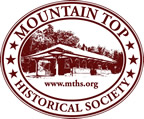
By Bob Gildersleeve
In 1883, Hotel Kaaterskill builder, owner and well-known Philadelphia lawyer, George Harding, commissioned Hexamer and Sons of Philadelphia, to conduct a fire safety survey of his then 3-year old hotel. This stunningly precise and detailed survey has escaped the view of the many historians and collectors who are avid about the Hotel's history, but was discovered this past winter by MTHS member Scott Koster in The Philadelphia Free Library. Scott shared his finding with us and it has proved to be a gold mine of data about the Hotel. The on-line images of the survey from the Philadelphia library only hinted at the precision of the document so we contacted the Free Library of Philadelphia’s map department. We thank them for providing the Mountain Top Historical Society a beautiful high resolution scan of the document. It joins the nearly 50 photographs taken in about 1920 just prior to the Harding family’s sale of the property given to us by George M. Harding, great great grandson of the Hotel’s builder.
Taken together, the Hexamer survey and the Harding photos, provide us with a key to deciphering the the layout and many of the operations of the enormous hotel. They also have become the spring board for new questions. The spectacular fire of September 8, 1924 destroyed the hotel leaving a jumble of footings and other remains now largely hidden among the trees that have grown in the 95 years since the hotel’s destruction.
On April 25th, 2019, in preparation for hike to the Hotel Kaaterskill site later that Spring, Pete Senterman, Bob Titus, Mike Kudish, John O'Grady, Jonathan Palmer and I with the Hexamer Survey, copies of the Harding photos, and tape measures in hand, walked around the Hotel site to make more precise determinations about many aspects of the Hotel's layout. The Hotel came into view more clearly than ever. The details of what we saw and learned follow, but I invite you to join us again this Spring on May 2nd and 3rd 2020 for a new program and a hike to explore the site of the Hotel with us and to share in the excitement of this new find." See the details in our events schedule. The May 2020 program has been canceled. We hope to reschedule.
The survey features accurate measurements of each part of the building allowing us to locate with certainty the footings of the ice house, and the helps’ quarters and water closet (toilets) – locations we’ve only speculated about before. We stood among the stone footings facing what had been the cartway to the courtyard and held up a Harding photo – they fit together perfectly. But, despite the accuracy of the document there are discrepancies with the Harding photos or the current condition of the site. Some of the discrepancies are clearly minor oversights and some cause confusion or raise questions that and need to be resolved. What can we make of the 6 ft. high stone ledge running through the courtyard? It doesn’t show on the plan or appear in the Harding photos and it certainly didn’t result from a major geological upheaval in the past 95 years. Such discrepancies lead to discoveries and the document promises to open many new discoveries.
There are significant hints about the infrastructure for electric and gas lighting used at the hotel. The electric lighting was powered by “Arnoux’s and Hotchhausen’s electric arc lights.” The firm was a competitor of Edison. The electric dynamo was a mile from the hotel. [An 1890 Windham Journal article about the fire at the Laundry mentions that "...the force pumps that supply the hotel with water, and the electric light plant..." were located there] The gas for gas lighting was manufactured by a “Maxim Gasoline Machine...housed in a stone building 119’ from the nearest building.” The gasoline was vaporized and mixed with air – like a giant Coleman lantern and piped to the hotel. Our research indicates that Maxim was Hiram Maxim, best known as inventor of the first fully automatic machine gun. Our challenge is to use these hints to discover more about the Hotel and its operation.



